04
A Brief history about the life cycle of trees
Wagdy El Komy
write, restore, document
narrative, metaforth, literary
Cairo, history, trees
What can trees tell each other after they have been cut down? This text aspires to be multi-visionary and cannot be classified in any specific category. It is a book that narrates the cultural erosion to which Cairo has been subjected to in the last decade after the revolution of January 25th, 2011. I also intend to create a map of the areas where concrete structures appeared that distorted the civilized character of the city and intentionally destroyed environmental places in order to impose security control over the city.
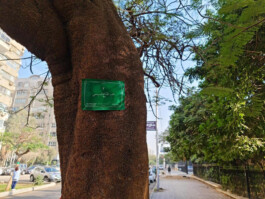
The first chapter of my master project

Cairo… the oldest city in history. Facing the most difficult times. Egyptian youth are unjustly exiled or imprisoned for saying No.
And its trees have been cut down.
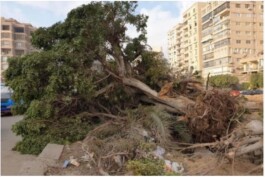
What can trees tell each other when they are cut down...?
This text aspires to be multi-visionary and cannot be classed in any specific category, it is a book that narrates the cultural erosion to which Cairo has been subjected in the last decade after the revolution of January 25, 2011.
I also intend to create a map of the areas where concrete structures appeared that distorted the civilized character of the city and intentionally destroyed the environmental spots in order to impose security control over the city. Moreover, I intend to include a detailed presentation on the relationship of the author of these lines with Tahrir Square, where the revolution of January 25 took place, and a brief presentation about the history of the field and the political transformations that occurred in it.
Why did I choose to write about trees and to use it as a main theme of this texts? As a metaphor for Cairo...? or as a metaphor for those who had to emigrate while the trees can’t move?
I often feel that my story is closer to the story of a tree, because it was cut down, it is more like this exile that I have to experience , I am exiled in Switzerland because I said no, and trees have been cut down because they cannot be on the side of those who decided to cut them, because whoever cuts them sees them as an opponent, due to their standing on the street and looking up to the sky, it represents a challenge to those who do not understand how they are living creatures that can stand in the street with such audacity.
Trees in Cairo represent a strange opponent to the “Sisi” regime, something we have never imagined since the outbreak of the Egyptian revolution in 2011. We did not imagine that a dictator would one day come and start cutting down trees. We understand the dictatorship’s hostility to the political opposition. But why is the dictator afraid of a tree?
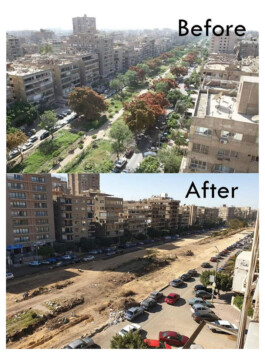
I don't know why a dictator armed with tanks, armored vehicles and soldiers, would feel afraid of a tree in the street, on the road, maybe because trees give people something, they give them pure oxygen atoms, maybe the green color gives people a meaning to continue, to dream.
I imagine whenever a tree is being cut down, and a pillar is planted in its place to support a bridge, that the city turns from places where tall trees used to rise, into a prison. The bars of its windows, these bars are parallel, lined up as if they stand one behind the other, or stand next to each other, and the pillars of the bridge, while standing behind each other to support the bridge, also resemble the soldiers who stand in Egypt securing the roads while “Sisi” drives by in his motorcade, which consists of more than one luxury vehicle, including vehicles with jamming devices, to cut off communications at the places where the convoy passes, because of fear that someone will use mobile phone signals to set off a bomb.
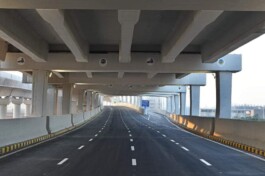
Can the trees tell their stories as they are being felled? Can we think of these trees as beings standing up against the dictatorship just as humans also stand up to the dictator when they revolt in the streets...?
I do not know if it was possible to collect the stories of the trees before they were cut down. I am thinking here during this long text, to collect the locations of the trees where they have been cut down in Cairo, and to tell the stories of the changes that occurred in Cairo.
I want to be free enough to talk about Tahrir Square, which has changed its shape. And I want to talk about the transfer of artistic authority from certain sites in Cairo to other sites, but my urgent question remains, why is Sisi afraid of trees..?
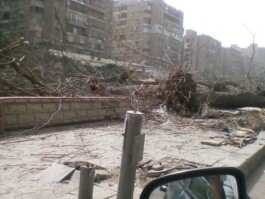
Is the dictator afraid of trees, because they are standing organisms?
And in their stand, do they represent models of steadfastness and symbolic protest, even if they are silent?
I imagine that trees are cut down by “Sisi’s” order because he imagines trees as living creatures standing in the street, representing a threat to his regime and his authority, and he, like any tyrannical regime, worries about the presence of any living creature in the street, whether it is a human walking on his feet, chanting, and waving his arm against the regime’s practices and thus his anxiety can be extended to the trees, as standing, unbending creatures, whose branches resemble the arms of a protesting human being.
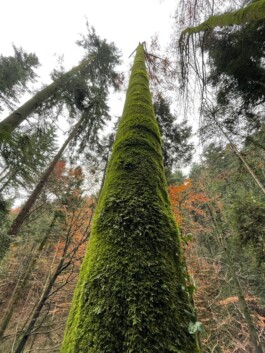
This is a picture of a tree I took somewhere in Switzerland. At that time, I was going through a difficult time, isolated from my family and children. During this time, I had not seen them since April 2021. When I took this picture, I was thinking that I came to Switzerland because of my rejection of the transformations sweeping the city. I could not accept the transformations. The difficult times Cairo is going through, at a period of its life ruled by a regime that believes gaining more control over the city means killing its living creatures, cutting down trees, clearing gardens, planting more and more bridges in order to quickly transport armored vehicles and troop carriers, to strenghten control over the city.
Bridges against trees
Both have arms and branches.
Bridges are concrete objects planted by the political regime to control the city, and trees are planted by people to add green to their lives, the color of hope.
Green is the color that we in Egypt understand when we want to describe something beautiful. Or hope. A good wish, as we say: Your day is green.
The Flood Tree:
Couldn’t we avoid cutting down all those trees in order to punish unbelievers?
(40) [So it was], until when Our command came and the oven overflowed,[559] We said, "Load upon it [i.e., the ship] of each [creature] two mates and your family, except those about whom the word [i.e., decree] has preceded, and [include] whoever has believed." But none had believed with him, except a few. (Surah Hood-Qoran Kareem).
I often have doubts about the feasibility of cutting down all these trees to build a ship to save some creatures and a few people from the world that is drowning.
The world had to drown to end the era of the oppressors, who did not believe in Noah and his message, but has the world become a good place after that? After the flood? The trees had been cut down for the construction of the ark ..Noah's ship..?
As a writer, I can think about the feasibility of anything and re-imagine what if it did not happen. What if the trees were God's means and his command to Noah to save creatures from drowning? What if choosing a specific spot on earth for Noah and his followers to move to instead of flooding the earth and those on it. Was cutting down the trees a really necessary act in order to construct the ark? Why God didn’t give a command to Noah to build a wall like the same order was given to Alexander the two Horned?
I also think that trees, as upright beings, while standing and staring at the sky, are the most incapable beings on earth to say no, or to resist attempts to cut them down, and therefore the repetition of the act of cutting down trees, their growth despite their cutting, and humans being forced to plant more of them, is like a partial victory for the trees, as the trees are cut down without resisting their cutters, after a period of time they grow, or they are planted, and so the person returns to declare his submission to the trees and plants more of them after discovering that the land/city/streets without trees was a big mistake.
There is another matter.
Cutting down trees in order to build the ship was a divine order, and a divine guarantee for the trees too, that cutting them down is a temporary matter, for an immediate, temporal change, the reasons which will disappear by achieving the purpose of building the ship, and not a tyrannical order to build new cities or to obliterate the features of a city, or restraining an expected revolt, or securing a city and blockading its inhabitants from suddenly revolting.
Samia Henni, writer, historian and professor of architecture, says that the construction of cities has a connection with securing the city and controlling the people who live in the city.
Architecture is like an open archive; Where buildings carry all layers of history within them. Most European capitals were built as a result of the exploitative conditions that colonialism brought to the world. So modernity is not only a legacy of colonialism, but it is part of the same project. For example, the Swiss architect Le Corbusier, one of the pioneers of European modernist architecture, participated in the colonial project.
In 1930, the French colonial authorities organized several festive events to mark the 100th anniversary of the French colonization of Algeria. After these events, Le Corbusier was invited to Algiers by the then influential 'Association d'Urbanisme Les Amis d'Alger', where he was asked to present a new design for Algiers to replace the Kasbah, which had been the center of the historical capital for centuries. At that time, with a remarkable showmanship, Le Corbusier presented a design for a huge project that would completely destroy the urban fabric of Algiers, along with the social and religious customs of the time.
Its urban planning according to the methods of modern architecture, the descendant of modern architecture, did not conflict at all with the colonial project. For Le Corbusier's vision, there were two completely separate parts of Algiers, the "Islamic city" and the "European city". The large scale of his project aimed primarily at introducing a radical change in the spatial arrangement and ensuring what was then called "law and order".
But don't we also find this attempt to establish order in European cities? For example, the well-known French urban planner and politician Georges-Eugène Haussmann had parts of Paris razed to the ground in the 19th century to create more order in the city.
This is an excellent example; because the French army, after arriving in Algiers in 1830, and seeing the so called “chaos” of the Kasbah, demolished a large part of this urban fabric in order to impose a very strict “order” on the city. They destroyed the houses and built a broad avenue, straight streets, and a large square called "La Place d'Armes" (Arms Square). This allowed the French soldiers to monitor the population better, and they themselves became more visible.
A Brief history about the life cycle of trees
Wagdy El Komy
write, restore, document
narrative, metaforth, literary
Cairo, history, trees
What can trees tell each other after they have been cut down? This text aspires to be multi-visionary and cannot be classified in any specific category. It is a book that narrates the cultural erosion to which Cairo has been subjected to in the last decade after the revolution of January 25th, 2011. I also intend to create a map of the areas where concrete structures appeared that distorted the civilized character of the city and intentionally destroyed environmental places in order to impose security control over the city.

The first chapter of my master project

Cairo… the oldest city in history. Facing the most difficult times. Egyptian youth are unjustly exiled or imprisoned for saying No.
And its trees have been cut down.

What can trees tell each other when they are cut down...?
This text aspires to be multi-visionary and cannot be classed in any specific category, it is a book that narrates the cultural erosion to which Cairo has been subjected in the last decade after the revolution of January 25, 2011.
I also intend to create a map of the areas where concrete structures appeared that distorted the civilized character of the city and intentionally destroyed the environmental spots in order to impose security control over the city. Moreover, I intend to include a detailed presentation on the relationship of the author of these lines with Tahrir Square, where the revolution of January 25 took place, and a brief presentation about the history of the field and the political transformations that occurred in it.
Why did I choose to write about trees and to use it as a main theme of this texts? As a metaphor for Cairo...? or as a metaphor for those who had to emigrate while the trees can’t move?
I often feel that my story is closer to the story of a tree, because it was cut down, it is more like this exile that I have to experience , I am exiled in Switzerland because I said no, and trees have been cut down because they cannot be on the side of those who decided to cut them, because whoever cuts them sees them as an opponent, due to their standing on the street and looking up to the sky, it represents a challenge to those who do not understand how they are living creatures that can stand in the street with such audacity.
Trees in Cairo represent a strange opponent to the “Sisi” regime, something we have never imagined since the outbreak of the Egyptian revolution in 2011. We did not imagine that a dictator would one day come and start cutting down trees. We understand the dictatorship’s hostility to the political opposition. But why is the dictator afraid of a tree?

I don't know why a dictator armed with tanks, armored vehicles and soldiers, would feel afraid of a tree in the street, on the road, maybe because trees give people something, they give them pure oxygen atoms, maybe the green color gives people a meaning to continue, to dream.
I imagine whenever a tree is being cut down, and a pillar is planted in its place to support a bridge, that the city turns from places where tall trees used to rise, into a prison. The bars of its windows, these bars are parallel, lined up as if they stand one behind the other, or stand next to each other, and the pillars of the bridge, while standing behind each other to support the bridge, also resemble the soldiers who stand in Egypt securing the roads while “Sisi” drives by in his motorcade, which consists of more than one luxury vehicle, including vehicles with jamming devices, to cut off communications at the places where the convoy passes, because of fear that someone will use mobile phone signals to set off a bomb.

Can the trees tell their stories as they are being felled? Can we think of these trees as beings standing up against the dictatorship just as humans also stand up to the dictator when they revolt in the streets...?
I do not know if it was possible to collect the stories of the trees before they were cut down. I am thinking here during this long text, to collect the locations of the trees where they have been cut down in Cairo, and to tell the stories of the changes that occurred in Cairo.
I want to be free enough to talk about Tahrir Square, which has changed its shape. And I want to talk about the transfer of artistic authority from certain sites in Cairo to other sites, but my urgent question remains, why is Sisi afraid of trees..?

Is the dictator afraid of trees, because they are standing organisms?
And in their stand, do they represent models of steadfastness and symbolic protest, even if they are silent?
I imagine that trees are cut down by “Sisi’s” order because he imagines trees as living creatures standing in the street, representing a threat to his regime and his authority, and he, like any tyrannical regime, worries about the presence of any living creature in the street, whether it is a human walking on his feet, chanting, and waving his arm against the regime’s practices and thus his anxiety can be extended to the trees, as standing, unbending creatures, whose branches resemble the arms of a protesting human being.

This is a picture of a tree I took somewhere in Switzerland. At that time, I was going through a difficult time, isolated from my family and children. During this time, I had not seen them since April 2021. When I took this picture, I was thinking that I came to Switzerland because of my rejection of the transformations sweeping the city. I could not accept the transformations. The difficult times Cairo is going through, at a period of its life ruled by a regime that believes gaining more control over the city means killing its living creatures, cutting down trees, clearing gardens, planting more and more bridges in order to quickly transport armored vehicles and troop carriers, to strenghten control over the city.
Bridges against trees
Both have arms and branches.
Bridges are concrete objects planted by the political regime to control the city, and trees are planted by people to add green to their lives, the color of hope.
Green is the color that we in Egypt understand when we want to describe something beautiful. Or hope. A good wish, as we say: Your day is green.
The Flood Tree:
Couldn’t we avoid cutting down all those trees in order to punish unbelievers?
(40) [So it was], until when Our command came and the oven overflowed,[559] We said, "Load upon it [i.e., the ship] of each [creature] two mates and your family, except those about whom the word [i.e., decree] has preceded, and [include] whoever has believed." But none had believed with him, except a few. (Surah Hood-Qoran Kareem).
I often have doubts about the feasibility of cutting down all these trees to build a ship to save some creatures and a few people from the world that is drowning.
The world had to drown to end the era of the oppressors, who did not believe in Noah and his message, but has the world become a good place after that? After the flood? The trees had been cut down for the construction of the ark ..Noah's ship..?
As a writer, I can think about the feasibility of anything and re-imagine what if it did not happen. What if the trees were God's means and his command to Noah to save creatures from drowning? What if choosing a specific spot on earth for Noah and his followers to move to instead of flooding the earth and those on it. Was cutting down the trees a really necessary act in order to construct the ark? Why God didn’t give a command to Noah to build a wall like the same order was given to Alexander the two Horned?
I also think that trees, as upright beings, while standing and staring at the sky, are the most incapable beings on earth to say no, or to resist attempts to cut them down, and therefore the repetition of the act of cutting down trees, their growth despite their cutting, and humans being forced to plant more of them, is like a partial victory for the trees, as the trees are cut down without resisting their cutters, after a period of time they grow, or they are planted, and so the person returns to declare his submission to the trees and plants more of them after discovering that the land/city/streets without trees was a big mistake.
There is another matter.
Cutting down trees in order to build the ship was a divine order, and a divine guarantee for the trees too, that cutting them down is a temporary matter, for an immediate, temporal change, the reasons which will disappear by achieving the purpose of building the ship, and not a tyrannical order to build new cities or to obliterate the features of a city, or restraining an expected revolt, or securing a city and blockading its inhabitants from suddenly revolting.
Samia Henni, writer, historian and professor of architecture, says that the construction of cities has a connection with securing the city and controlling the people who live in the city.
Architecture is like an open archive; Where buildings carry all layers of history within them. Most European capitals were built as a result of the exploitative conditions that colonialism brought to the world. So modernity is not only a legacy of colonialism, but it is part of the same project. For example, the Swiss architect Le Corbusier, one of the pioneers of European modernist architecture, participated in the colonial project.
In 1930, the French colonial authorities organized several festive events to mark the 100th anniversary of the French colonization of Algeria. After these events, Le Corbusier was invited to Algiers by the then influential 'Association d'Urbanisme Les Amis d'Alger', where he was asked to present a new design for Algiers to replace the Kasbah, which had been the center of the historical capital for centuries. At that time, with a remarkable showmanship, Le Corbusier presented a design for a huge project that would completely destroy the urban fabric of Algiers, along with the social and religious customs of the time.
Its urban planning according to the methods of modern architecture, the descendant of modern architecture, did not conflict at all with the colonial project. For Le Corbusier's vision, there were two completely separate parts of Algiers, the "Islamic city" and the "European city". The large scale of his project aimed primarily at introducing a radical change in the spatial arrangement and ensuring what was then called "law and order".
But don't we also find this attempt to establish order in European cities? For example, the well-known French urban planner and politician Georges-Eugène Haussmann had parts of Paris razed to the ground in the 19th century to create more order in the city.
This is an excellent example; because the French army, after arriving in Algiers in 1830, and seeing the so called “chaos” of the Kasbah, demolished a large part of this urban fabric in order to impose a very strict “order” on the city. They destroyed the houses and built a broad avenue, straight streets, and a large square called "La Place d'Armes" (Arms Square). This allowed the French soldiers to monitor the population better, and they themselves became more visible.